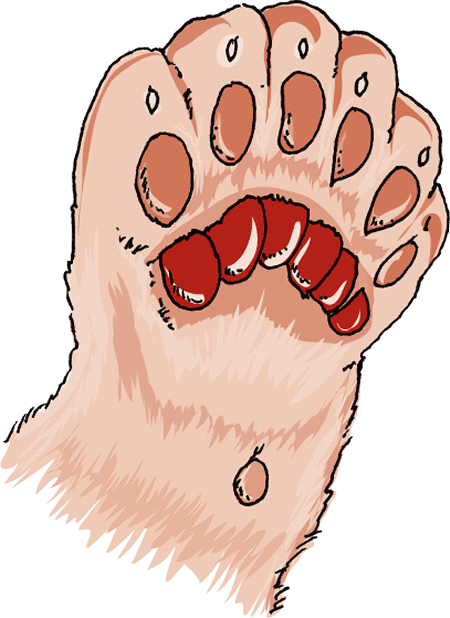Congenital and Inherited Disorders Affecting Multiple Body Systems of Cats
- Disorders Affecting Multiple Body Systems of Cats
- Introduction to Disorders Affecting Multiple Body Systems of Cats
- Congenital and Inherited Disorders Affecting Multiple Body Systems of Cats
- Amyloidosis in Cats
- Anthrax in Cats
- Ehrlichiosis and Related Infections in Cats
- Feline Infectious Peritonitis
- Feline Panleukopenia
- Fungal Infections in Cats
- Glanders (Farcy) in Cats
- Leishmaniasis in Cats
- Lyme Disease (Lyme Borreliosis) in Cats
- Melioidosis in Cats
- Nocardiosis in Cats
- Peritonitis in Cats
- Plague in Cats
- Q Fever in Cats
- Tetanus in Cats
- Toxoplasmosis in Cats
- Trichinellosis (Trichinosis) in Cats
- Tuberculosis in Cats
- Tularemia in Cats
Also see professional content regarding congenital and inherited disorders.
A variety of structural and functional defects have been described in animals. These defects are usually classified by the body system primarily affected, and many are discussed in this book under the appropriate body system section. Defective newborns have survived a disruptive event during embryonic or fetal development. Defective development may also cause embryonic loss, fetal death, mummification, abortion, stillbirth, or a newborn not capable of living.
Susceptibility to environmental agents or genetic abnormalities varies with the stage of development and species, and decreases with fetal age. The fertilized egg is resistant to agents or factors that cause or increase the rate of occurrence of a congenital defect (teratogens), but it is susceptible to genetic mutations and changes in the chromosomes. The embryo is highly susceptible to teratogens, but this susceptibility decreases with age as the critical developmental periods of various organs or organ systems are passed. The fetus becomes increasingly resistant to teratogens except for structures that develop late such as the cerebellum, palate, urinary system, and genitals.
The frequency of individual defects varies with the species, breed, geographic location, season, and other environmental factors. Among domestic animals, cats have the lowest frequency of congenital defects. Some reported congenital and inherited defects in cats include lack of development of the cerebellum (which controls the balance function), eye and eyelid defects, heart defects, cleft palate, failure of one or both testicles to descend into the scrotum (known as cryptorchidism), more toes than normal (polydactyly), and diaphragmatic and umbilical hernias. Most congenital defects have no clearly established cause; others are caused by genetic or environmental factors or interaction between these factors.
Genetic Factors
Inherited defects resulting from mutant genes or chromosome abnormalities tend to occur in patterns of inheritance. Such patterns include dominant (in which the defect will occur if either parent supplies an abnormal gene to its offspring), recessive (in which both parents must supply an abnormal gene) or others, such as sex‑linked (in which the gene is associated with the X chromosome and not the Y chromosome). In cats, for example, the appearance of excess toes follows a dominant pattern of inheritance, while diaphragmatic hernia follows a recessive pattern.
Some common diseases or disorders caused by genetic defects include deficiencies of particular enzymes that lead to the body’s inability to perform normal metabolic functions, and chromosome abnormalities that can result in sterility, abnormal growth, increased embryonic mortality, or reduced litter size. Viruses, certain drugs, and radiation are common causes of chromosomal damage.
The complex interaction between genetic and environmental factors is being studied and is slowly becoming better understood.
Environmental Factors
Factors tending to produce abnormalities of formation include toxic plants, viral infections that occur during pregnancy (such as feline panleukemia), drugs, trace elements, nutritional deficiencies, and physical agents such as radiation, abnormally high body temperature, and uterine positioning. These factors may be difficult to identify, often follow seasonal patterns and stress, and may be linked to maternal disease. They do not follow the pattern of family inheritance that is shown by genetic changes.
Also see professional content regarding congenital and inherited disorders.
- Disorders Affecting Multiple Body Systems of Cats
- Introduction to Disorders Affecting Multiple Body Systems of Cats
- Congenital and Inherited Disorders Affecting Multiple Body Systems of Cats
- Amyloidosis in Cats
- Anthrax in Cats
- Ehrlichiosis and Related Infections in Cats
- Feline Infectious Peritonitis
- Feline Panleukopenia
- Fungal Infections in Cats
- Glanders (Farcy) in Cats
- Leishmaniasis in Cats
- Lyme Disease (Lyme Borreliosis) in Cats
- Melioidosis in Cats
- Nocardiosis in Cats
- Peritonitis in Cats
- Plague in Cats
- Q Fever in Cats
- Tetanus in Cats
- Toxoplasmosis in Cats
- Trichinellosis (Trichinosis) in Cats
- Tuberculosis in Cats
- Tularemia in Cats







